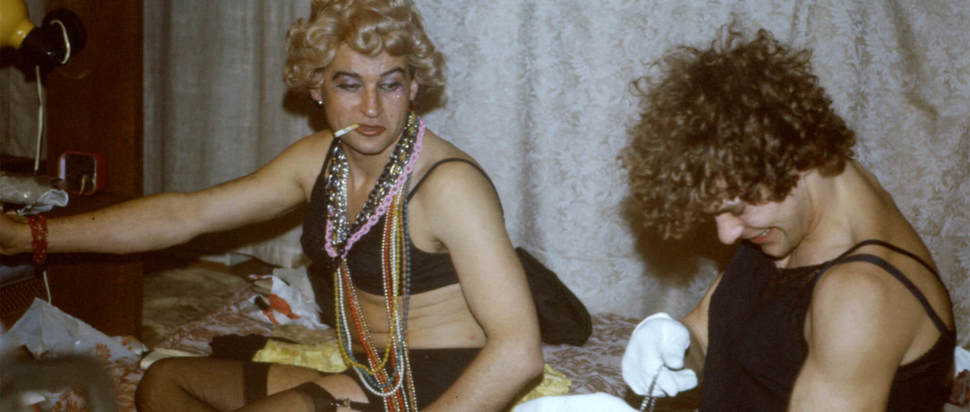Edinburgh Art Festival: Karol Radziszewski's Filo
One writer reflects on Karol Radziszewski's exhibition at City Art Centre, which offered an opportunity to understand Polish queer histories and the importance of queer archiving
Situated on the third floor of the City Art Centre, Karol Radziszewski's Filo exhibition offers an intimate glimpse into the hidden world of Polish queer histories in an amalgamation of both art and activism. Co-commissioned by Edinburgh Art Festival and Auto Italia, Radziszewski’s carefully curated display features rare photographs, publications, and ephemera that trace the roots of Filo, one of Central-Eastern Europe’s pioneering underground queer magazines, founded by the activist Ryszard Kisiel.
Kisiel initiated Filo in 1986 as an act of resistance against Operation Hyacinth, a nationwide crackdown by Poland’s Ministry of Internal Affairs, targeting sexual minorities. This campaign of intimidation and surveillance prompted Kisiel to create a space where queer voices could be heard, and vital information on legal rights and sexual health could be shared. The magazine's name, Filo, is derived from the Polish phonetic transcription of the Greek word "philo," meaning "friend" or "beloved"—a term Kisiel used in communication with his friends and lovers. Originally distributed informally amongst a close-knit network, Filo served as an outlet for those navigating the oppressive realities of the time, providing reader letters, homoerotic content, and essays addressing issues of sexuality and legality.
Radziszewski’s exhibition presents a case study of Filo within an evocative setting reminiscent of an Eastern European classroom. In this curated space, seven cases display a small yet impactful selection from Radziszewski’s extensive archive, highlighting the DIY, handmade ethos that characterised Filo during its formative years. The displays trace the magazine’s evolution from its initial collages and early issues, to the increasing influence of American pop culture imagery in the late 1980s. This shift occurred as Poland transitioned from communism to capitalism following the collapse of the Eastern Bloc in 1989. The juxtaposition of these archival materials underscores Filo's dual role as both a cultural artefact and a form of resistance, reaffirming its significance in the broader context of European queer history.
To mark his first solo exhibition in Scotland, Radziszewski also presents a series of paintings depicting queer historical figures from Central and Eastern Europe. These works – part of his ongoing series, The Gallery of Portraits – bring to light the lives of individuals who, due to their sexuality, identity, or political views, faced marginalisation or persecution before the fall of the Iron Curtain. The paintings are displayed in a manner reminiscent of the portraits of state figures often displayed in public institutions such as schools across the Eastern Bloc, where they served as tools of propaganda. Radziszewski subverts this format, using it instead to honour those whose contributions to queer history have been overlooked or censored.
Radziszewski’s exhibition emphasises the rich, often-ignored stories of queer communities in Central-Eastern Europe by combining visual arts and historical documentation. The exhibition serves as a powerful reminder of the importance of preserving and studying queer archives – not just those like Filo, but also archives closer to home, such as those found in Edinburgh.
Scotland’s own queer history is well-documented in archives that serve as vital resources for understanding the experiences and struggles of Scotland's LGBTQ+ community. The Lothian Health Services Archive, for instance, offers extensive records detailing the lives of queer people across Scotland, while the Lavender Menace Queer Books Archive preserves an important collection of queer literature and history. Much like Radziszewski’s work, these institutions highlight the crucial role that archives play in safeguarding and celebrating the stories that form Scotland’s queer heritage.
Radziszewski’s exhibition not only illustrates a significant chapter of Polish queer history but also invites reflection on the broader implications of queer archiving. By placing these materials in dialogue with contemporary Scotland, the exhibition bridges past and present, reminding us of the ongoing need to protect and honour the diverse histories of queer communities everywhere.
Karol Radziszewski: Filo ran at City Art Centre, Edinburgh, throughout the 2024 Edinburgh Art Festival.
This article was commissioned as part of Edinburgh Art Festival's Emerging Writers programme
